13.05.2018
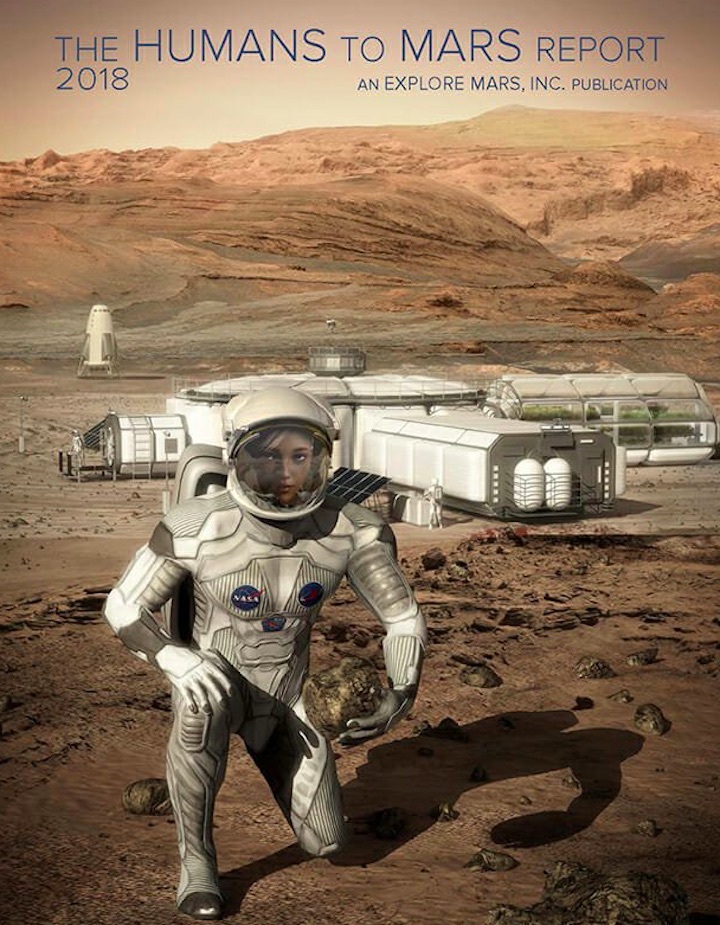
The Humans to Mars Report (H2MR) is an annual publication that presents a snapshot of current progress in mission architectures, science, domestic and international policy, human factors, and public perception regarding human missions to Mars - and highlights progress and challenges from year to year. By doing so,
H2MR provides stakeholders and policy makers with an invaluable resource to assist them in making decisions that are based on current facts rather than on the dated information and speculation that sometimes tends to persist in the public arena where Mars is concerned.
H2MR does not advocate any particular approach to getting to Mars, nor will this report address speculation or rumor about future architectures - except when such are impacting public perception and policy decisions.
While recently there has been some shift in emphasis in United States near-term space policy, the goal of human missions to Mars in the 2030s still maintains broad-based bi-partisan support, with unwavering support coming from NASA, Congress, and industry. Public interest in Mars also remains strong, as evidenced by a continuing stream of Mars-related consumer products as well as productions by the entertainment industry.
As always, through the publication of the Humans to Mars Report, Explore Mars is not discounting the prospect of human exploration of other destinations in the solar system. In fact, we embrace them, as long as they do not significantly delay human missions to Mars. We view Mars as a critical destination that will enable the exploration and development of space – and we firmly believe that humanity should set the goal of landing humans on the surface of Mars by 2033.
Chris Carberry
Chief Executive Officer Explore Mars, Inc.
Artemis Westenberg President
Explore Mars, Inc.
+++
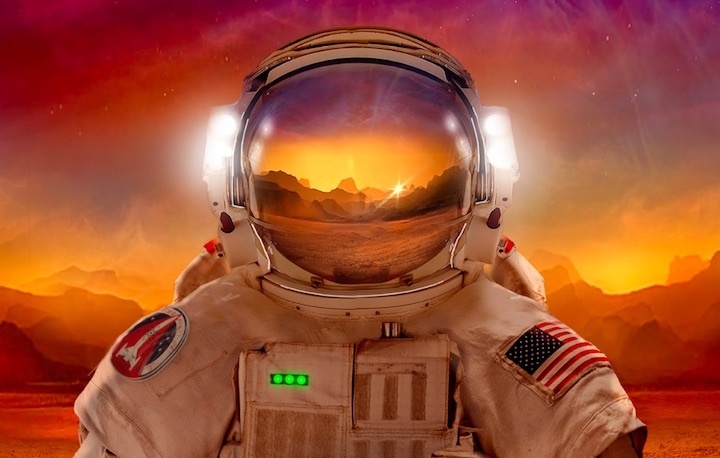
INTRODUCTION
Our nation has long recognized the immeasurable benefits that our space program brings to our economy, our prosperity, and our national security. This is reflected in the strong support that exists in the political realm, among the general public, and elsewhere for achieving the goal of humans walking on the surface
of Mars in the 2030s. The momentum that has been building for many years to send humans to Mars has continued unabated during the past year.
With the enactment and signing into law in March 2017 of the NASA Transition Authorization Act of 2017, the legislative and executive branches of government reaffirmed their bipartisan commitment to expanding human presence beyond low Earth orbit, with the aim of launching a human spaceflight mission to Mars by the year 2033. This is a goal and timeframe that has been advocated by Explore Mars, Inc. for many years. Since our 2017 report was published, the National Space Council was created by Executive Order in June 2017, and the President issued a Memorandum in December 2017 that was designated as Space Policy Directive #1 (SP1), both of which have added a greater short-term emphasis on the utilization of the Moon; however, no changes have been made to United States policy to send humans to Mars.
Over the past year much work has been done to further scheduled robotic missions (such as the 2018 Mars InSight lander and the Mars 2020 rover). Such robotic missions are necessary precursors to future human missions. However, our aging fleet of Mars orbiters will require replacement in the near future, and a Mars Sample Return mission is also considered to be a top priority for the 2020s. These future robotic missions will maximize scientific goals as well as advance human exploration in the 2030s.
Work on architectural concepts and refinements has also continued over the past year within NASA, in academia, and in industry. These concepts have placed particular emphasis on addressing commonalities among the various architectural approaches and concepts, as well as the many “long pole” technologies that must be developed in order to send humans to Mars. One example is the fifth Mars Achievability and Sustainability Workshop (AM V) that was held in Washington, DC in December 2017, which was specifically tasked with the development of architectures to achieve different “end states” of human exploration of the Mars system within the decade of the 2030s.
In addition, exciting work is being performed on the “human factors” associated with deep space missions, in order to mitigate overall risk to astronauts. These include research on the effects of long-term exposure to radiation and microgravity as well as studies on an advanced food technology portfolio that are underway to examine nutrient degradation in foods stored under different environmental conditions.
Finally, the fascination of the general public for human missions to Mars is perhaps best evidenced by the extensive and growing number of Mars exploration themes that continue to appear in the media, in the entertainment industry, and even in consumer products.
The goal of walking on Mars has always held a special place in the collective consciousness of all humanity. We can now achieve that goal in less than two decades. As was once correctly said about the Moon and can now be said about Mars: We only have to make the decision to go there.
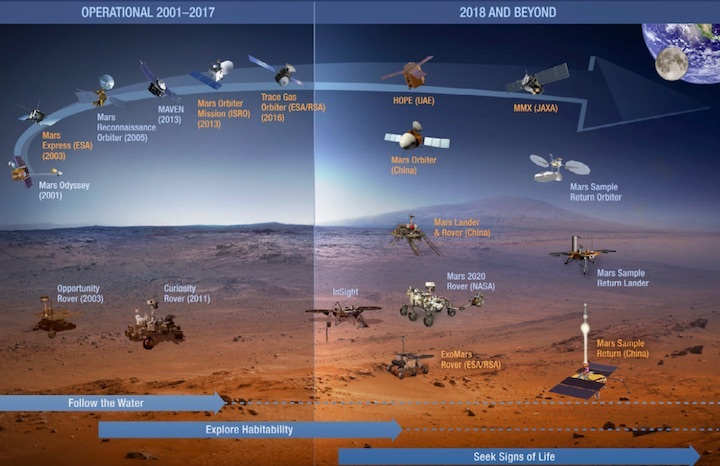
MARS SCIENCESetting the Scene for Human Exploration
The pace of scientific discoveries about Mars with implications for future exploration and human-based activities has continued unabated during the past year (2017-2018). Ongoing observations by the fleet of Mars orbiters (Figure 1) have furthered the case for a “dynamic Mars”, including exciting new discoveries about the
distribution of shallow but thick reservoirs of ground ice. On the surface, the analysis from both the Curiosity rover and the Opportunity rover point to a Mars with a history of water and possible preservation of the signatures of life. Exploration awaits us on the Red Planet as we plan the Mars Sample Return (MSR) mission in the 2020s and human exploration in the 2030s.
Thanks to our existing Mars robotic fleet, 2017 saw multiple breakthroughs/milestones in Mars science. Some examples relevant to future human exploration include:
-
The discovery of exposed subsurface water-ice deposits on cliffs near the poles. This exciting discovery provides visual confirmation of previous predictions. The water ice on Mars is real, it’s accessible, and it’s in great quantities in the form of thick, spatially extensive deposits (Figure 2).
-
The reaffirmation of the dominant theory that the surface of Mars cannot support liquid water, even briny, on the surface. This is based on the identification of Recurring Slope Lineae (RSLs) as dry granular flows. That being said, scientists have not ruled out that liquid water is somehow involved in this process. Further investigation is clearly called for to resolve this significant issue.
-
Research showed that dust devils on Mars have the potential to throw dust particles (sub-micron scale) around the globe. This work has broad implications for planetary protection protocols in that any terrestrial microbes released on Mars have the potential to spread around the globe.
-
The discoveries from MAVEN coupled with those from MRO suggest there may have once been an era in which thick deposits of ice were episodically formed, eroded, and released as liquid surface waters, only to freeze again. These subsurface remnant glacial deposits are key areas for the search for life and have the potential to be used by future human explorers.
-
The ESA/ROSCOSMOS Trace Gas Orbiter (TGO) completed its aerobraking at Mars and successfully entered its science orbit, armed with a powerful payload for studying the Martian atmosphere.
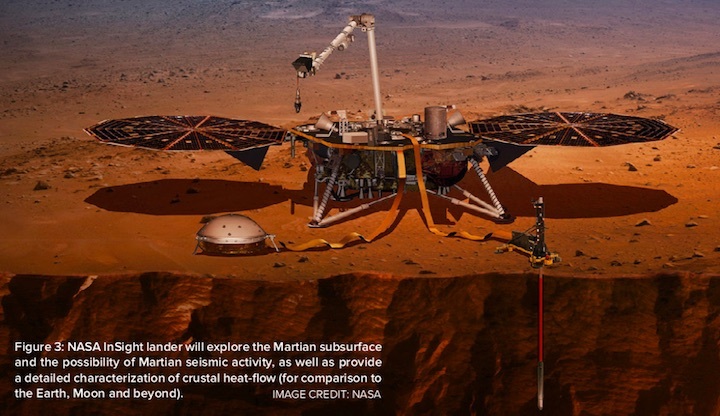
Looking ahead, the upcoming landing of the Mars InSight lander will be a key step in characterizing the interior of Mars and comparing it with other rocky planets. TGO will also begin its science mission to provide better atmospheric maps and new observations of critical trace gases later this year.
Mission preparation for the NASA Mars 2020 rover also continues. The primary objective of this mission is to cache carefully-selected Martian samples with the intention of returning them to Earth in later missions. In addition, Mars 2020 will employ a multi-frequency mobile ground penetrating radar contributed by Norway (the Radar Imager for Mars’ Subsurface Experiment, or RIMFAX) to sense tens of meters below the surface in search of interfacing layers associated with water ice at extremely fine vertical scales. In other ways, the “vertical mobility” that the ExoMars 2020 rover will demonstrate with its 2m subsurface drill will finally expose materials shielded from the ravages of deep space radiation to sensors such as the Mars Organics Molecule Analyzer (MOMA) instrument developed jointly by NASA and Germany. MOMA is the first instrument that should be capable of detecting complex organic molecules associated uniquely with the preserved record of life as we understand it here on Earth, or if not, untangle what fragments of such complex molecules can be preserved on Mars. The Mars 2020 rover will also carry an ISRU demonstration experiment (Mars OXygen In situ resource utilization Experiment, or MOXIE) to commence engineering evaluation and validation of strategies for “living off the planet” as an enabler of sustained human occupation in the future. Finally, Mars 2020 will demonstrate hazard-awareness and response via its Terrain Relative Navigation (TRN) capabilities which will increase the accessibility of scientifically important sites on Mars.
Furthermore, initial steps are underway to retrieve the Mars 2020 rover cache samples on a future robotic mission, potentially in the late 2020’s. Actively-unfolding plans for this subsequent sample return lander will also demonstrate an ascent vehicle and associated Earth return orbiter. This mission would be the first robotic roundtrip demonstration to and from Mars. Surface-based sample return is a major National Academy of Sciences Decadal Survey (Visions and Voyages, 2011) science priority, and has been since the 1980s. Additionally, there is growing evidence that Martian samples are needed to inform future human missions by means of what they will teach us about the mechanical properties of the regolith/dust (abrasiveness, oxidizing potential, particle size, etc.) and potential human health hazards (toxicity, respiratory, extant life, etc.). Science Mission Directorate Associate Administrator Thomas Zurbuchen provided the first public outline of NASA’s MSR strategy at a National Academies Space Studies board in August 2017.
There are other international Mars mission plans as well. In 2020 the UAE, ESA, JAXA, and CNSA are all launching orbiters or landers to the Martian system. In 2022 ISRO will be launching a successor to its tremendously successful Mars Orbiter Mission (MOM), and in 2024 JAXA will launch its MMX mission to examine and even sample the Martian moons.
Despite the remarkable successes cited above, NASA’s budgetary and political constraints make the launching of necessary robotic missions in the years following the Mars 2020 Rover far from assured. There is no new mission funding beyond 2020.
In addition to Mars Sample Return activities, there are several potential missions that will support global efforts as we prepare for future human exploration. It is essential that we have a plan to replace the aging orbital assets currently at Mars which enable relay of vital science data and situational awareness. These potential missions include:
-
A resource reconnaissance orbiter. Necessary to fill key knowledge gaps about potential water resources at Mars. This is critical for the search for life and to understand the potential of this water to support human operations at Mars (e.g., propellant, consumption, agriculture, etc.).
-
A special regions drilling mission to verify and characterize the water deposits found with the next generation reconnaissance orbiter.
-
Improved orbital and surface weather monitoring. This will help us achieve pinpoint landings of landers delivering human Mars mission surface assets and to understand the potential transport of microbes across the surface of the planet.
-
Improved tele-communications capabilities. Given the aging communications assets at Mars and the expected increased data rates required by science and eventual human assets, relay between the Earth and Mars will need to be improved and extended.
Science has always offered the gateway information to promote and expedite human exploration. Most recently, in her review of the Apollo 8 human mission to the Moon, science writer Mary Roach poignantly stated: “It was science that got us to the Moon – not just its mastery but a cultural consensus about its importance and worth.” [Washington Post, April 2018]. The science activities on the Red Planet are demonstrating the importance of exploration; they are showing the world that Mars is achievable as our next human frontier beyond cislunar space.
ARCHITECTURES AND SYSTEMSCurrent Progress of Elements Required for Mars
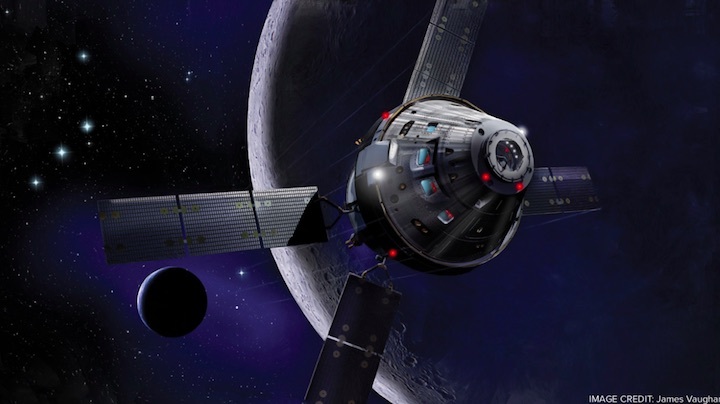
Subsequent to the publication of the Humans to Mars Report (H2MR) in May 2017, work on architectural concepts and refinements continued within NASA, in academia, and at many industrial partners. With the recent re- establishment of the National Space Council, a policy shift that might influence the direction of Mars planning
was widely expected. However, as that policy has unfolded, it now appears that many of the same factors that were previously widely adopted will continue as before: a public-private partnership, the Moon as a candidate proving ground for Mars exploration, and appropriate international participation.
In this section, we discuss both the major elements of current architectures for Mars exploration and recent results from the latest in the series of community workshops known as the Achievability and Sustainability of Human Exploration of Mars Workshops (AM V), which are jointly sponsored by Explore Mars, Inc. and the American Astronautical Society (see https://www.exploremars.org/affording-mars ).
MI. Utilization of Cislunar Space on the Way to Mars
uch of the recent work within industry has focused on a habitat and operations facility in orbit in the vicinity of the Moon, which has gone by multiple names over almost two decades of design development, and recently has been referred to as the Lunar Orbiting Platform-Gateway (or Gateway). Both the European Space Agency
(ESA) and NASA have recently hosted workshops on utilization of this facility to achieve major science goals and advance technological preparation for Mars exploration.
In 2002, an architecture based specifically on a facility for extended human occupation and operations in cislunar space was first studied in depth by the Decadal Planning Team (DPT) in response to a request from the NASA Administration and the Office of Management and Budget. A top-level visualization of the proposed architecture is shown in Figure 1, where the Gateway was the central element of a variety of options for human and robotic space exploration, including utilizing it not only to oversee robotic lunar surface operations but also as an aggregation site in preparation for human missions to Mars.
With the recent renewed interest in sustained human operations in cislunar space, the Gateway has now become, after the Space Launch System (SLS) and the Orion crew vehicle, another element in industry architectures proposed by Aerojet Rocketdyne, Boeing, Lockheed Martin, Orbital ATK, and Sierra Nevada Corporation. In current architectures, it serves as a bridge between the experiences gained from research and development on the International Space Station (ISS) and the systems needed to reliably send humans to Mars. Such a facility could also provide a means to demonstrate key technologies required for the Deep Space Habitat and Power and Propulsion elements (discussed in the next section) demonstrating human ability to live and work at increased distance and duration from Earth as well as facilitating science and astrophysics research. In addition, it could serve as the location where the Mars Transfer Vehicle (MTV) is aggregated and supplied, and then refurbished upon its return to the Earth-Moon vicinity. The renewed interest in lunar exploration and the desire to provide an infrastructure that can be utilized by private companies and international partners to perform resource surveys and additional scientific research could also be satisfied by such a Gateway.
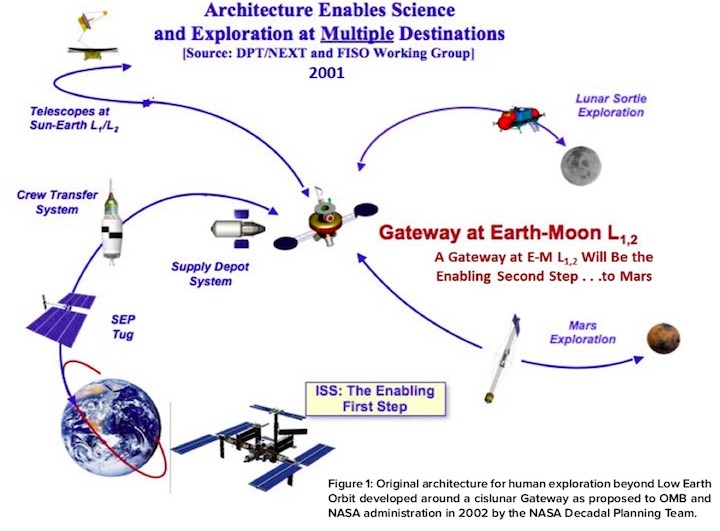
II. Industry Architectures
s described in previous editions of the Humans to Mars Report, most industry architectures for Mars exploration
have coalesced into six key elements (Figure 2), to advance capabilities to support human
exploration.
Work is now beginning on the Power and Propulsion as well as the Habitat requirements for deep space missions. This means that the demonstration of the Transit elements for human missions to Mars– the deep space habitat and the power and propulsion tug – is beginning to take shape.
Other architecture elements that are common to many industry plans include entry, descent, and landing (EDL) for heavy payloads and Mars ascent vehicle designs. Over the past year additional emphasis has
Figure 2: The six elements of a Mars architecture

